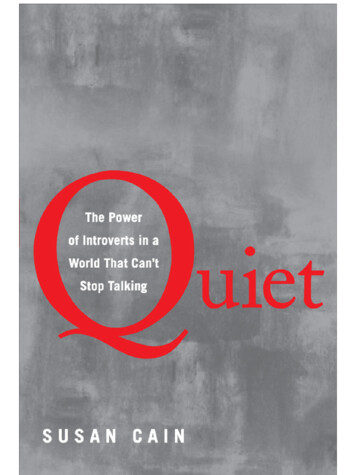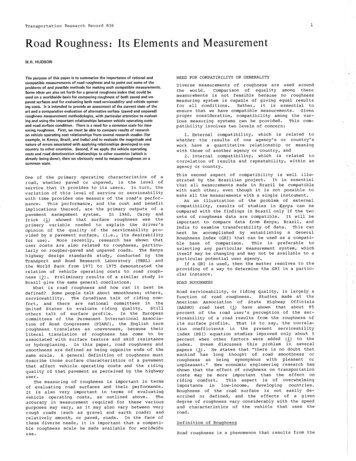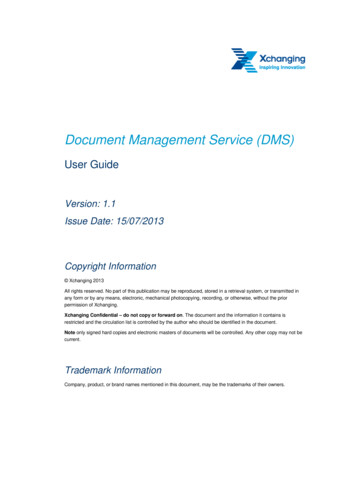
Transcription
MORE ADVANCE NOISE FOR QUIET“An intriguing and potentially lifealtering examination of the humanpsyche that is sure to benefit bothintroverts and extroverts alike.”—Kirkus Reviews (starred review)“Gentle is powerful Solitude is socially productive These importantcounterintuitive ideas are among themany reasons to take Quiet to a quietcorner and absorb its brilliant,thought-provoking message.”—ROSABETH MOSS KANTER, professor at Harvard Business School, authorof Confidence and SuperCorp“An informative, well-researchedbook on the power of quietness and the
3/929virtues of having a rich inner life. It dispels the myth that you have to be extroverted to be happy and successful.”—JUDITH ORLOFF, M.D., author ofEmotional Freedom“In this engaging and beautifullywritten book, Susan Cain makes apowerful case for the wisdom of introspection. She also warns us ably aboutthe downside to our culture’s noisiness,including all that it risks drowning out.Above the din, Susan’s own voice remainsacompellingpresence—thoughtful, generous, calm,and eloquent. Quiet deserves a verylarge readership.”—CHRISTOPHER LANE, author of Shyness: How Normal Behavior Became aSickness
4/929“Susan Cain’s quest to understand introversion, a beautifully wrought journey from the lab bench to the motivational speaker’s hall, offers convincing evidence for valuing substanceover style, steak over sizzle, and qualities that are, in America, often derided.This book is brilliant, profound, fullof feeling and brimming withinsights.”—SHERI FINK, M.D., author of WarHospital“Brilliant, illuminating, empowering! Quiet gives not only a voice, but apath to homecoming for so manywho’ve walked through the better partof their lives thinking the way they engage with the world is something inneed of fixing.”
5/929—JONATHAN FIELDS, author of Uncertainty: Turning Fear and Doubt into Fuelfor Brilliance“Once in a blue moon, a book comesalong that gives us startling new insights. Quiet is that book: it’s part pageturner, part cutting-edge science. Theimplications for business are especiallyvaluable: Quiet offers tips on how introverts can lead effectively, give winningspeeches, avoid burnout, and choosethe right roles. This charming, gracefully written, thoroughly researchedbook is simply masterful.”—ADAM M. GRANT, PH.D., associateprofessor of management, the WhartonSchool of Business
6/929STILL MORE ADVANCE NOISE FORQUIET“Shatters misconceptions Cain consistently holds the reader’s interest bypresenting individual profiles and reporting on the latest studies. Her diligence, research, and passion for thisimportant topic has richly paid off.”—Publishers Weekly“Quiet elevates the conversation aboutintroverts in our outwardly oriented society to new heights. I think thatmany introverts will discover that,even though they didn’t know it,they have been waiting for this bookall their lives.”—ADAM S. MCHUGH, author of Introverts in the Church
7/929“Susan Cain’s Quiet is wonderfully informative about the culture of the extravert ideal and the psychology of asensitive temperament, and she is helpfully perceptive about how introvertscan make the most of their personalitypreferences in all aspects of life. Society needs introverts, so everyone canbenefit from the insights in this important book.”—JONATHAN M. CHEEK, professor ofpsychology at Wellesley College, co-editor of Shyness: Perspectives on Researchand Treatment“A brilliant, important, and personally affecting book. Cain shows that,for all its virtue, America’s ExtrovertIdeal takes up way too much oxygen.Cain herself is the perfect person tomake this case—with winning graceand clarity she shows us what it
8/929looks like to think outside thegroup.”—CHRISTINE KENNEALLY, author ofThe First Word“What Susan Cain understands—andreaders of this fascinating volume willsoon appreciate—is something that psychology and our fast-moving and fasttalking society have been all too slowto realize: Not only is there reallynothing wrong with being quiet, reflective, shy, and introverted, butthere are distinct advantages to being this way.—JAY BELSKY, Robert M. and NatalieReid Dorn Professor, Human and Community Development, University ofCalifornia, Davis“Author Susan Cain exemplifies herown quiet power in this exquisitely
9/929written and highly readable pageturner. She brings important researchand the introvert experience.”—JENNIFER B. KAHNWEILER, PH.D.,author of The Introverted Leader“Several aspects of Quiet are remarkable. First, it is well informed by the research literature but not held captiveby it. Second, it is exceptionally wellwritten, and ‘reader friendly.’ Third,it is insightful. I am sure many peoplewonder why brash, impulsive behaviorseems to be rewarded, whereas reflective, thoughtful behavior is overlooked.This book goes beyond such superficialimpressions to a more penetratinganalysis.”—WILLIAM GRAZIANO, professor, Department of Psychological Sciences,Purdue University
Copyright 2012 by Susan CainAll rights reserved.Published in the United States by Crown Publishers, an imprint of the CrownPublishing Group, a division of Random House,Inc., New York.www.crownpublishing.comCROWN and the Crown colophon are registeredtrademarks of Random House, Inc.The BIS/BAS Scales on this page–this pagecopyright 1994 by the American Psychological Association. Adapted with permission.From “Behavioral Inhibition, Behavioral Activation, and Affective Responses to Impending Reward and Punishment: The BIS/BAS Scales.”Journal of Personality and Social Psychology67(2): 319–33. The use of APA informationdoes not imply endorsement by APA.
12/929Library of Congress Cataloging-in-PublicationDataCain, Susan.Quiet : the power of introverts in a world thatcan’t stop talking / Susan Cain.—1st ed.p. cm.1. Introverts. 2. Introversion. 3. Extroversion.4. Interpersonal relations. I. Title.BF698.35.I59C35 2012155.2′32—dc222010053204eISBN: 978-0-307-45220-7Jacket design by Laura DuffyJacket photography by Joe Ginsberg/GettyImagesv3.1
To my childhood family
A species in which everyone was GeneralPatton would not succeed, any more thanwould a race in which everyone was Vincent van Gogh. I prefer to think that theplanet needs athletes, philosophers, sexsymbols, painters, scientists; it needs thewarmhearted, the hardhearted, the coldhearted, and the weakhearted. It needsthose who can devote their lives to studying how many droplets of water aresecreted by the salivary glands of dogs under which circumstances, and it needsthose who can capture the passing impression of cherry blossoms in a fourteen-syllable poem or devote twenty-five pages tothe dissection of a small boy’s feelings ashe lies in bed in the dark waiting for hismother to kiss him goodnight. Indeedthe presence of outstanding strengths
15/929presupposes that energy needed in otherareas has been channeled away fromthem.—ALLEN SHAWN
ContentsCoverTitle PageCopyrightDedicationEpigraphAuthor’s NoteINTRODUCTION: The North and South ofTemperamentPART ONE: THE EXTROVERT IDEAL1. THE RISE OF THE “MIGHTY LIKEABLEFELLOW”: How Extroversion Became theCultural Ideal
17/9292. THE MYTH OF CHARISMATICLEADERSHIP: The Culture of Personality, aHundred Years Later3. WHEN COLLABORATION KILLSCREATIVITY: The Rise of the New Groupthink and the Power of Working AlonePART TWO: YOUR BIOLOGY, YOURSELF?4. IS TEMPERAMENT DESTINY?: Nature,Nurture, and the Orchid Hypothesis5. BEYOND TEMPERAMENT: The Role ofFree Will (and the Secret of Public Speakingfor Introverts)6. “FRANKLIN WAS A POLITICIAN, BUTELEANOR SPOKE OUT OF CONSCIENCE”:Why Cool Is Overrated
18/9297. WHY DID WALL STREET CRASH ANDWARREN BUFFETT PROSPER?: How Introverts and Extroverts Think (and Process Dopamine) DifferentlyPART THREE: DO ALL CULTURESHAVE AN EXTROVERT IDEAL?8. SOFT POWER: Asian-Americans and theExtrovert IdealPART FOUR: HOW TO LOVE, HOWTO WORK9. WHEN SHOULD YOU ACT MOREEXTROVERTED THAN YOU REALLY ARE?10. THE COMMUNICATION GAP: How toTalk to Members of the Opposite Type
19/92911. ON COBBLERS AND GENERALS: How toCultivate Quiet Kids in a World That Can’tHear ThemCONCLUSION: WonderlandA Note on the DedicationA Note on the Words Introvert and ExtrovertAcknowledgmentsNotes
Author’s NoteI have been working on this book officially since 2005, and unofficially formy entire adult life. I have spoken andwritten to hundreds, perhaps thousands, of people about the topicscovered inside, and have read as manybooks, scholarly papers, magazinearticles, chat-room discussions, andblog posts. Some of these I mention inthe book; others informed almost everysentence I wrote. Quiet stands on manyshoulders, especially the scholars andresearchers whose work taught me somuch. In a perfect world, I would havenamed every one of my sources, mentors, and interviewees. But for the sakeof readability, some names appear onlyin the Notes or Acknowledgments.
21/929For similar reasons, I did not use ellipses or brackets in certain quotationsbut made sure that the extra or missingwords did not change the speaker’s orwriter’s meaning. If you would like toquote these written sources from theoriginal, the citations directing you tothe full quotations appear in the Notes.I’ve changed the names and identifying details of some of the people whosestories I tell, and in the stories of myown work as a lawyer and consultant.To protect the privacy of the participants in Charles di Cagno’s publicspeaking workshop, who did not planto be included in a book when theysigned up for the class, the story of myfirst evening in class is a compositebased on several sessions; so is thestory of Greg and Emily, which is basedon many interviews with similarcouples. Subject to the limitations of
22/929memory, all other stories are recountedas they happened or were told to me. Idid not fact-check the stories peopletold me about themselves, but only included those I believed to be true.
INTRODUCTIONThe North and South ofTemperamentMontgomery, Alabama. December 1,1955. Early evening. A public bus pullsto a stop and a sensibly dressed womanin her forties gets on. She carries herself erectly, despite having spent theday bent over an ironing board in adingy basement tailor shop at theMontgomery Fair department store. Herfeet are swollen, her shoulders ache.She sits in the first row of the Coloredsection and watches quietly as the busfills with riders. Until the driver ordersher to give her seat to a whitepassenger.
24/929The woman utters a single word thatignites one of the most important civilrights protests of the twentieth century,one word that helps America find itsbetter self.The word is “No.”The driver threatens to have herarrested.“You may do that,” says Rosa Parks.A police officer arrives. He asks Parkswhy she won’t move.“Why do you all push us around?”she answers simply.“I don’t know,” he says. “But the lawis the law, and you’re under arrest.”On the afternoon of her trial and conviction for disorderly conduct, theMontgomery Improvement Associationholds a rally for Parks at the Holt StreetBaptist Church, in the poorest sectionof town. Five thousand gather to support Parks’s lonely act of courage. They
25/929squeeze inside the church until its pewscan hold no more. The rest wait patiently outside, listening through loudspeakers. The Reverend Martin LutherKing Jr. addresses the crowd. “Therecomes a time that people get tired ofbeing trampled over by the iron feet ofoppression,” he tells them. “Therecomes a time when people get tired ofbeing pushed out of the glittering sunlight of life’s July and left standingamidst the piercing chill of an AlpineNovember.”He praises Parks’s bravery and hugsher. She stands silently, her mere presence enough to galvanize the crowd.The association launches a city-widebus boycott that lasts 381 days. Thepeople trudge miles to work. They carpool with strangers. They change thecourse of American history.
26/929I had always imagined Rosa Parks asa stately woman with a bold temperament, someone who could easily standup to a busload of glowering passengers. But when she died in 2005 at theage of ninety-two, the flood of obituaries recalled her as soft-spoken, sweet,and small in stature. They said she was“timid and shy” but had “the courageof a lion.” They were full of phraseslike “radical humility” and “quiet fortitude.” What does it mean to be quietand have fortitude? these descriptionsasked implicitly. How could you be shyand courageous?Parks herself seemed aware of thisparadox, calling her autobiographyQuiet Strength—a title that challenges usto question our assumptions. Whyshouldn’t quiet be strong? And whatelse can quiet do that we don’t give itcredit for?
27/929Our lives are shaped as profoundly bypersonality as by gender or race. Andthe single most important aspect of personality—the “north and south of temperament,” as one scientist puts it—iswhere we fall on the introvert-extrovertspectrum. Our place on this continuuminfluences our choice of friends andmates, and how we make conversation,resolve differences, and show love. Itaffects the careers we choose andwhether or not we succeed at them. Itgoverns how likely we are to exercise,commit adultery, function well withoutsleep, learn from our mistakes, placebig bets in the stock market, delay gratification, be a good leader, and ask“what if.”* It’s reflected in our brainpathways,neurotransmitters,and
28/929remote corners of our nervous systems.Today introversion and extroversionare two of the most exhaustively researched subjects in personality psychology, arousing the curiosity of hundredsof scientists.These researchers have made excitingdiscoveries aided by the latest technology, but they’re part of a long andstoried tradition. Poets and philosophers have been thinking about introvertsand extroverts since the dawn of recorded time. Both personality types appearin the Bible and in the writings ofGreek and Roman physicians, and someevolutionary psychologists say that thehistory of these types reaches back evenfarther than that: the animal ” as we’ll see, from fruitflies to pumpkinseed fish to rhesusmonkeys. As with other complementary
29/929pairings—masculinity and femininity,East and West, liberal and conservative—humanity would be unrecognizable, and vastly diminished, withoutboth personality styles.Take the partnership of Rosa Parksand Martin Luther King Jr.: a formidable orator refusing to give up his seaton a segregated bus wouldn’t have hadthe same effect as a modest womanwho’d clearly prefer to keep silent butfor the exigencies of the situation. AndParks didn’t have the stuff to thrill acrowd if she’d tried to stand up and announce that she had a dream. But withKing’s help, she didn’t have to.Yet today we make room for a remarkably narrow range of personalitystyles. We’re told that to be great is tobe bold, to be happy is to be sociable.We see ourselves as a nation of extroverts—which means that we’ve lost
30/929sight of who we really are. Dependingon which study you consult, one thirdto one half of Americans are introverts—in other words, one out of everytwo or three people you know. (Giventhat the United States is among themost extroverted of nations, the number must be at least as high in otherparts of the world.) If you’re not an introvert yourself, you are surely raising,managing, married to, or coupled withone.If these statistics surprise you, that’sprobably because so many people pretend to be extroverts. Closet introvertspass undetected on playgrounds, inhigh school locker rooms, and in thecorridors of corporate America. Somefool even themselves, until some lifeevent—a layoff, an empty nest, an inheritance that frees them to spend timeas they like—jolts them into taking
31/929stock of their true natures. You haveonly to raise the subject of this bookwith your friends and acquaintances tofind that the most unlikely people consider themselves introverts.It makes sense that so many introverts hide even from themselves. Welive with a value system that I call theExtrovert Ideal—the omnipresent beliefthat the ideal self is gregarious, alpha,and comfortable in the spotlight. Thearchetypal extrovert prefers action tocontemplation, risk-taking to heed-taking, certainty to doubt. He favors quickdecisions, even at the risk of beingwrong. She works well in teams and socializes in groups. We like to think thatwe value individuality, but all too oftenwe admire one type of individual—thekind who’s comfortable “putting himself out there.” Sure, we allow technologically gifted loners who launch
32/929companies in garages to have any personality they please, but they are theexceptions, not the rule, and our tolerance extends mainly to those who getfabulously wealthy or hold the promiseof doing so.Introversion—along with its cousinssensitivity, seriousness, and shyness—isnow a second-class personality trait,somewhere between a disappointmentand a pathology. Introverts living underthe Extrovert Ideal are like women in aman’s world, discounted because of atrait that goes to the core of who theyare. Extroversion is an enormously appealing personality style, but we’veturned it into an oppressive standard towhich most of us feel we must conform.The Extrovert Ideal has been documented in many studies, though this research has never been grouped under asingle name. Talkative people, for
33/929example, are rated as smarter, betterlooking, more interesting, and more desirable as friends. Velocity of speechcounts as well as volume: we rank fasttalkers as more competent and likablethan slow ones. The same dynamics apply in groups, where research showsthat the voluble are considered smarterthan the reticent—even though there’szero correlation between the gift of gaband good ideas. Even the word introvertis stigmatized—one informal study, bypsychologist Laurie Helgoe, found thatintroverts described their own physicalappearance in vivid language s”), but when asked to describe generic introverts they drew ablandanddistastefulpicture(“ungainly,” “neutral colors,” “skinproblems”).
34/929But we make a grave mistake to embrace the Extrovert Ideal so unthinkingly. Some of our greatest ideas, art,and inventions—from the theory ofevolution to van Gogh’s sunflowers tothe personal computer—came fromquiet and cerebral people who knewhow to tune in to their inner worldsand the treasures to be found there.Without introverts, the world would bedevoid of:the theory of gravitythe theory of relativityW. B. Yeats’sComing”“TheSecondChopin’s nocturnesProust’s In Search of Lost TimePeter PanOrwell’s Nineteen Eighty-Four andAnimal Farm
35/929The Cat in the HatCharlie BrownSchindler’s List, E.T., and Close Encounters of the Third KindGoogleHarry Potter*As the science journalist WinifredGallagher writes: “The glory of the disposition that stops to consider stimulirather than rushing to engage withthem is its long association with intellectual and artistic achievement.Neither E mc2 nor Paradise Lost wasdashed off by a party animal.” Even inless obviously introverted occupations,like finance, politics, and activism,some of the greatest leaps forward weremade by introverts. In this book we’llsee how figures like Eleanor Roosevelt,Al Gore, Warren Buffett, Gandhi—and
36/929Rosa Parks—achieved what they didnot in spite of but because of theirintroversion.Yet, as Quiet will explore, many ofthe most important institutions of contemporary life are designed for thosewho enjoy group projects and highlevels of stimulation. As children, ourclassroom desks are increasingly arranged in pods, the better to fostergroup learning, and research suggeststhat the vast majority of teachers believe that the ideal student is an extrovert. We watch TV shows whose protagonists are not the “children nextdoor,” like the Cindy Bradys andBeaver Cleavers of yesteryear, but rockstars and webcast hostesses with outsizedpersonalities,likeHannahMontana and Carly Shay of iCarly. EvenSid the Science Kid, a PBS-sponsoredrole model for the preschool set, kicks
37/929off each school day by performingdance moves with his pals. (“Check outmy moves! I’m a rock star!”)As adults, many of us work for organizations that insist we work in teams, inoffices without walls, for supervisorswho value “people skills” above all. Toadvance our careers, we’re expected topromote ourselves unabashedly. Thescientists whose research gets fundedoften have confident, perhaps overconfident, personalities. The artists whosework adorns the walls of contemporarymuseums strike impressive poses at gallery openings. The authors whose booksget published—once accepted as a reclusive breed—are now vetted by publicists to make sure they’re talk-showready. (You wouldn’t be reading thisbook if I hadn’t convinced my publisherthat I was enough of a pseudo-extrovertto promote it.)
38/929If you’re an introvert, you also knowthat the bias against quiet can causedeep psychic pain. As a child you mighthave overheard your parents apologizefor your shyness. (“Why can’t you bemore like the Kennedy boys?” theCamelot-besotted parents of one man Iinterviewed repeatedly asked him.) Orat school you might have been proddedto come “out of your shell”—that noxious expression which fails to appreciate that some animals naturally carryshelter everywhere they go, and thatsome humans are just the same. “Allthe comments from childhood still ringin my ears, that I was lazy, stupid,slow, boring,” writes a member of an email list called Introvert Retreat. “Bythe time I was old enough to figure outthat I was simply introverted, it was apart of my being, the assumption thatthere is something inherently wrong
39/929with me. I wish I could find that littlevestige of doubt and remove it.”Now that you’re an adult, you mightstill feel a pang of guilt when you decline a dinner invitation in favor of agood book. Or maybe you like to eatalone in restaurants and could dowithout the pitying looks from fellowdiners. Or you’re told that you’re “inyour head too much,” a phrase that’soften deployed against the quiet andcerebral.Of course, there’s another word forsuch people: thinkers.I have seen firsthand how difficult it isfor introverts to take stock of their owntalents, and how powerful it is when finally they do. For more than ten years I
40/929trained people of all stripes—corporatelawyers and college students, hedgefund managers and married couples—innegotiation skills. Of course, wecovered the basics: how to prepare for anegotiation, when to make the first offer, and what to do when the other person says “take it or leave it.” But I alsohelped clients figure out their naturalpersonalities and how to make the mostof them.My very first client was a young woman named Laura. She was a WallStreet lawyer, but a quiet and daydreamy one who dreaded the spotlightand disliked aggression. She had managed somehow to make it through thecrucible of Harvard Law School—aplace where classes are conducted inhuge, gladiatorial amphitheaters, andwhere she once got so nervous that shethrew up on the way to class. Now that
41/929she was in the real world, she wasn’tsure she could represent her clients asforcefully as they expected.For the first three years on the job,Laura was so junior that she never hadto test this premise. But one day thesenior lawyer she’d been working withwent on vacation, leaving her in chargeof an important negotiation. The clientwas a South American manufacturingcompany that was about to default on abank loan and hoped to renegotiate itsterms; a syndicate of bankers thatowned the endangered loan sat on theother side of the negotiating table.Laura would have preferred to hideunder said table, but she was accustomed to fighting such impulses.Gamely but nervously, she took herspot in the lead chair, flanked by herclients: general counsel on one side andsenior financial officer on the other.
42/929These happened to be Laura’s favoriteclients: gracious and soft-spoken, verydifferent from the master-of-the-universe types her firm usually represented. In the past, Laura had taken thegeneral counsel to a Yankees game andthe financial officer shopping for ahandbag for her sister. But now thesecozy outings—just the kind of socializing Laura enjoyed—seemed a worldaway. Across the table sat nine disgruntled investment bankers in tailoredsuits and expensive shoes, accompaniedby their lawyer, a square-jawed womanwith a hearty manner. Clearly not theself-doubtingtype,thiswomanlaunched into an impressive speech onhow Laura’s clients would be luckysimply to accept the bankers’ terms. Itwas, she said, a very magnanimousoffer.
43/929Everyone waited for Laura to reply,but she couldn’t think of anything tosay. So she just sat there. Blinking. Alleyes on her. Her clients shifting uneasily in their seats. Her thoughts runningin a familiar loop: I’m too quiet for thiskind of thing, too unassuming, too cerebral. She imagined the person whowould be better equipped to save theday: someone bold, smooth, ready topound the table. In middle school thisperson, unlike Laura, would have beencalled “outgoing,” the highest accoladeher seventh-grade classmates knew,higher even than “pretty,” for a girl, or“athletic,” for a guy. Laura promisedherself that she only had to make itthrough the day. Tomorrow she wouldgo look for another career.Then she remembered what I’d toldher again and again: she was an introvert, and as such she had unique
44/929powers in negotiation—perhaps less obvious but no less formidable. She’dprobably prepared more than everyoneelse. She had a quiet but firm speakingstyle. She rarely spoke without thinking. Being mild-mannered, she couldtake strong, even aggressive, positionswhile coming across as perfectly reasonable. And she tended to ask questions—lots of them—and actually listento the answers, which, no matter whatyour personality, is crucial to strongnegotiation.So Laura finally started doing whatcame naturally.“Let’s go back a step. What are yournumbers based on?” she asked.“What if we structured the loan thisway, do you think it might work?”“That way?”“Some other way?”
45/929At first her questions were tentative.She picked up steam as she went along,posing them more forcefully and making it clear that she’d done her homework and wouldn’t concede the facts.But she also stayed true to her ownstyle, never raising her voice or losingher decorum. Every time the bankersmade an assertion that seemed unbudgeable, Laura tried to be constructive. “Are you saying that’s the only wayto go? What if we took a differentapproach?”Eventually her simple queries shiftedthe mood in the room, just as the negotiation textbooks say they will. Thebankers stopped speechifying anddominance-posing, activities for whichLaura felt hopelessly ill-equipped, andtheystartedhavinganactualconversation.
46/929More discussion. Still no agreement.One of the bankers revved up again,throwing his papers down and stormingout of the room. Laura ignored this display, mostly because she didn’t knowwhat else to do. Later on someone toldher that at that pivotal moment she’dplayed a good game of somethingcalled “negotiation jujitsu”; but sheknew that she was just doing what youlearn to do naturally as a quiet personin a loudmouth world.Finally the two sides struck a deal.The bankers left the building, Laura’sfavorite clients headed for the airport,and Laura went home, curled up with abook, and tried to forget the day’stensions.But the next morning, the lead lawyer for the bankers—the vigorous woman with the strong jaw—called to offer her a job. “I’ve never seen anyone
47/929so nice and so tough at the same time,”she said. And the day after that, thelead banker called Laura, asking if herlaw firm would represent his companyin the future. “We need someone whocan help us put deals together withoutletting ego get in the way,” he said.By sticking to her own gentle way ofdoing things, Laura had reeled in newbusiness for her firm and a job offer forherself. Raising her voice and poundingthe table was unnecessary.Today Laura understands that her introversion is an essential part of whoshe is, and she embraces her reflectivenature. The loop inside her head thataccused her of being too quiet and unassuming plays much less often. Lauraknows that she can hold her own whenshe needs to.
48/929What exactly do I mean when I say thatLaura is an introvert? When I startedwriting this book, the first thing Iwanted to find out was precisely howresearchers define introversion and extroversion. I knew that in 1921 the influential psychologist Carl Jung hadpublished a bombshell of a book, Psychological Types, popularizing the termsintrovert and extrovert as the centralbuilding blocks of personality. Introverts are drawn to the inner world ofthought and feeling, said Jung, extroverts to the external life of people andactivities. Introverts focus on the meaning they make of the events swirlingaround them; extroverts plunge into theevents themselves. Introverts rechargetheir batteries by being alone;
49/929extroverts need to recharge when theydon’t socialize enough. If you’ve evertaken a Myers-Briggs personality test,which is based on Jung’s thinking andused by the majority of universities andFortune 100 companies, then you mayalready be familiar with these ideas.But what do contemporary researchers have to say? I soon discovered thatthere is no all-purpose definition of introversion or extroversion; these arenot unitary categories, like “curlyhaired” or “sixteen-year-old,” in whicheveryone can agree on who qualifies forinclusion. For example, adherents ofthe Big Five school of personality psychology (which argues that human personality can be boiled down to fiveprimary traits) define introversion notin terms of a rich inner life but as alack of qualities suc
nothing wrong with being quiet, re-flective, shy, and introverted, but there are distinct advantages to be-ing this way. —JAY BELSKY, Robert M. and Natalie Reid Dorn Professor, Human and Com-munity Development, University of California, Davis "Author Susan Cain exemplifies her own quiet power in this exquisitely 8/929











